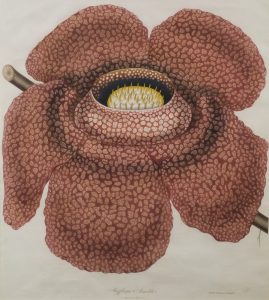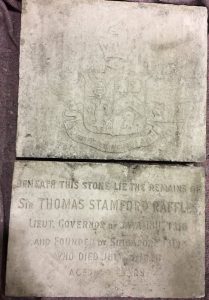Commemorating Sir Stamford Raffles
Thursday 5th July marks the anniversary of the death of Sir Stamford Raffles, who died the day before his 45th birthday in 1826. He was born on 6th July 1781 on the ship Ann, off the Jamaica coast. That must have been a trial for his mother, Anne, but Raffles survived and after an early education in boarding school, in 1795, aged just 14, he began work as a clerk for the East India Company in order to support his mother and four sisters. From there, began a very illustrious career. In 1805, he was sent to Malaya, and aged 23 he became Assistant Secretary to the newly formed government in Penang. Raffles was keen to learn and undertook extensive exploration of the language, history and culture of the Malayan people. His work brought him to the attention of Lord Minto, Governor-General of India, and Raffles was appointed the agent to prepare the way for a naval invasion to remove the French from Java. Raffles became Governor-General of Java in 1811 and he undertook a series of reforms to improve conditions in the islands.
He returned to England in 1816, was knighted in 1817 and appointed as the Governor-General of Bencoolen (now Bengkulu, Indonesia) and from this position, he then was instrumental in the founding of modern Singapore. Raffles returned to England in 1824, and he became a member of the Royal Asiatic Society. He died in his home, Highwood House, in Mill Hill, north London, being survived by his second wife, Sophia, Lady Raffles and daughter, Ella.
Raffles and his wife were generous benefactors to the Royal Asiatic Society. He presented this engraving of the flower from the plant named after him, Rafflesia Arnoldi, to the Society in March 1826.

They also donated many manuscripts from SE Asia, several of which have been digitsed and are available to be seen on our Digital Library. Please take advantage of this opportunity to view in details more than 20 manuscripts which had belonged to Raffles. Here is just a single page from Malay 39, Sejarah Melayu. Its clarity is somewhat reduced on the blogsite, so I would encourage you to try out the precision to be seen in the images on the Digital Library.

Both Sir Stamford and Lady Raffles were generous donors but recently we have gained a more unusual item connected with Sir Stamford Raffles. Earlier this year, we were contacted by a stonemason to say that he had the old gravestone of Sir Stamford Raffles in his garage. He had been commissioned to create a new stone in 1999 and had stored the old one, not sure what to do with it. However, as he was about to move, he inquired whether we would accept it. So, we are now in possession of Raffles’ original gravestone. It is difficult to see due to erosion, but on this gravestone it was wrongly recorded that Raffles had reached 45 years. This has been corrected on the new one.

Next week, on Wednesday 11 July, 6.30 pm, we welcome Farrukh Husain, who will be in conversation with Victoria Schofield, for a guest talk, “Afghanistan in the Age of Empires”. They will be discussing his acclaimed account of the first Afghan war detailing the role of Afghan women in combat, the respective merits of Afghan and British weaponry, and how and why the Kabul uprising occurred on the anniversary of the battle of Badr in 1841. We hope we can welcome many of you on this occasion.
